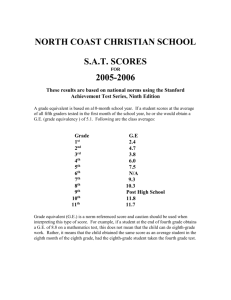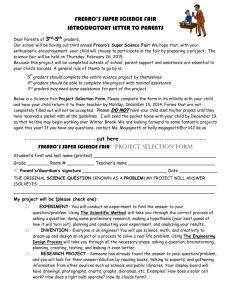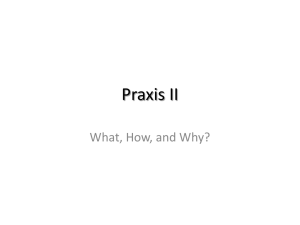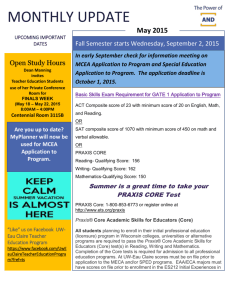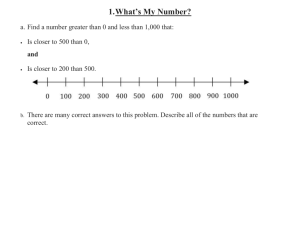A new twist on scientifically-oriented reading instruction
advertisement
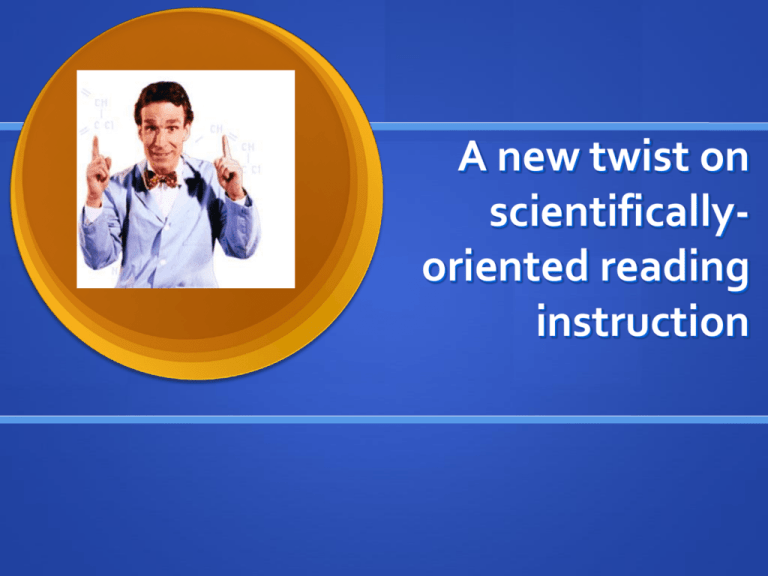
A new twist on scientificallyoriented reading instruction Afternoon Agenda We’ll start with a little bit of scientific team building Are you smarter than a 5th grader? Then we’ll link our new science knowledge with our new reading knowledge Distribute the trade books on your table among your group members Use the planning template to plan instruction Share within your group Share with individuals from other schools How is your science knowledge? We found many standardized test questions in the area of science. We found released items from 5th grade CRCT We found released items from the TIMSS (Third International Mathematics and Science Study) for 4th and 8th grade We found released items from the Praxis for middle school science teachers We found test items in the area of science and technology from MSNBC/USA Today Let’s get oriented! Are You Smarter Than a Fifth Grader? Part One Procedures We’ll show you each item We’ll give you some time to confer with your team We’ll practice Every Pupil Response All answers will be multiple choice: A, B, C, or D When we ring the bell, put up your answer 5th-Grade CRCT Released Items What happens to the movement of molecules when a substance is heated? A. They move more quickly. B. They move at the same time. C. They move more slowly. D. They stop moving. Which characteristic is true ONLY of mammals? A. They look like their parents. B. They live on land. C. They nurse their young. D. They have backbones. Diabetes is caused when the human body cannot properly use? A. fat. B. protein. C. sugar. D. water. What do ALL birds have in common? A. They fly. B. They have feathers. C. They migrate. D. They build nests in trees. One force causing the ocean to be in CONSTANT motion is A. volcanoes. B. earthquakes. C. plate tectonics. D. tides. A paper airplane thrown into the air does not fall as fast as a ball thrown into the air because the paper airplane has A. more air resistance. B. more inertia. C. more velocity. D. more acceleration. Most fish that live in the deepest part of the ocean have soft skeletons that allow them to survive the A. high water pressure. B. fast-moving currents. C. cold temperatures. D. salty water. When researching ideas about science, the best source of information would be A. popular radio. B. encyclopedias. C. science fiction books. D. comedy shows on TV. 4th-Grade TIMSS Released Items U.S. Fourth Graders: 54% U.S. Fourth Graders: 62% U.S. Fourth Graders: 46% 8th-Grade TIMSS Released Items U.S. Eighth Graders: 63% U.S. Eighth Graders: 47% U.S. Eighth Graders: 52% U.S. Eighth Graders: 57% Praxis Middle Grade Science Released Items According to some scientists, the Earth’s average surface temperature is rising as a result of the greenhouse effect. And increase in the atmospheric concentration of which of the following gases is considered to be primarily responsible? A. B. C. D. Nitrogen Oxygen Sulfur dioxide Carbon dioxide Praxis Middle School Science Finding that a solution conducts an electric current shows conclusively that the solution A. B. C. D. has a high boiling point contains molecules is a good oxidizing agent contains ions Praxis Middle School Science Some substances have no noticeable odor because these substances A. are soluble in water B. cannot lose the heat that must be lost before C. D. an odor can be detected have relatively few molecules escaping into the air do not have molecules with one of the two molecular arrangements required to give an odor Praxis Middle School Science Several vehicles, initially at a complete stop, begin a long race at the same starting point. The vehicle that has a constant value for which of the following is most likely to win? A. B. C. D. Linear speed Linear velocity Linear acceleration Momentum Praxis Middle School Science Now let’s read and plan The Architects introduced some important ideas today. Let’s apply them to sets of trade books that address Georgia Performance Standards in Science Take a look at the books, and distribute them among your team 2. Read your book. Use the planning template to guide your thinking: 1. 1. 2. 3. 4. Size up the book Decide how to preteach the main concept Decide how to build background knowledge Decide whether to highlight one or more text structures Resources to help The graphic organizers for today are displayed around the room; we have extras under each. Grab the one that is useful and stick it in your book; write out the actual words that you would use in your classroom Use sticky notes to mark your book for areas of difficulty that must be addressed Ask your colleagues! Everyone has ideas to offer about how to make complex ideas accessible to our children. What did the rest of your team accomplish? Use the sharing template to note the choices that people on your team made. Fill in the first column with notes about each text. You’ll see spots for all of our texts We’ll give you a signal to keep on track; you’ll have 5 minutes to share about each book. Now we need to share across schools Meeting new people can be awkward! How can we add some structure? Let’s use a process like speed dating to share In case you are interested . . . Speed dating is a formalized matchmaking process or dating system whose purpose is to encourage people to meet a large number of new people. Everyone is there to meet others No one is pressured to accept or reject anyone Individuals rotate after short intervals (http://en.wikipedia.org/wiki/Speed_dating) How are we going to do it? We’ll give you 8 minutes at a time to meet someone new and share information Concentrate on the different choices that your partner made When you hear the bell, you’ll have one minute to find a new match Your goal is to fill the second column of your sharing template Tomorrow We’ll be back for more! Afternoon Agenda We’ll start once again with a little bit of scientific team building Are you smarter than a 5th grader? Then we’ll link our new science knowledge with our new reading knowledge: Return to the trade books to extend your planning Share within your group Share with individuals from other schools You’re smarter today! But Are You Smarter Than a Fifth Grader? Part Two Procedures We’ll show you each item We’ll give you some time to confer with your team We’ll again practice Every Pupil Response When we ring the bell, put up your answer Remember, your choices are A, B, C, or D 5th-Grade CRCT Released Items 4th-Grade TIMSS Released Items U.S. Fourth Graders: 62% U.S. Fourth Graders: 31% U.S. Fourth Graders: 81% 8th-Grade TIMSS Released Items U.S. Eighth Graders: 40% U.S. Eighth Graders: 40% U.S. Eighth Graders: 78% U.S. Eighth Graders: 20% Praxis Middle Grade Science Released Items Which of the following statements is true of hurricanes but not of tornadoes? A. B. C. D. They form only over warm oceans. They have very high winds. The may cause great property damage. They may cause human fatalities. Praxis Middle School Science The agent most widely and most consistently at work changing the appearance of the Earth’s surface is A. B. C. D. fire volcanism water wind Praxis Middle School Science Which of the following is most directly involved with controlling levels of sugar in the blood ? A. Hemoglobin B. Calcitonin C. Thyroid-stimulating hormone D. Insulin Praxis Middle School Science In which of the following is the battery short-circuited? Praxis Middle School Science MSNBC/USA Today Science Items A. B. C. D. .12 miles 1.2 miles 12 miles 120 miles A. B. C. D. Cockroaches Snails Termites Worms A. B. C. D. David Crosby Graham Nash Stephen Stills Neil Young A. B. C. D. alligator dog elephant horse A. B. C. D. 4 12 19 23 Now let’s read and plan The Architects introduced some important ideas today. Let’s apply them to sets of trade books that address Georgia Performance Standards in Science 1. 2. Go back to the books Read your book again. Use the planning template to guide your thinking. 1. 2. 3. 4. Decide whether to highlight one or more comprehension strategies Decide where you will stop and what you will say during reading Decide what you will say and do after reading to deepen understanding Consider a follow-up activity Structured Collaborations Time to Share! Back in School How can you collaborate to make planning of truly interactive read-alouds easier?
